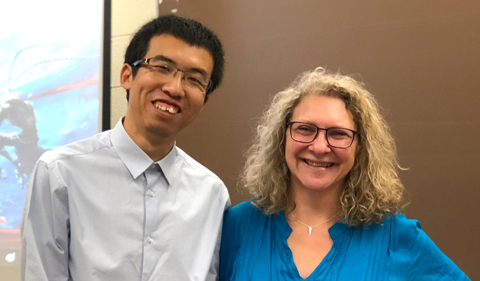Two Ohio University physicists who were part of an international collaboration reported results of a study on self-grown graphene nanoribbons in the paper, “Linking interlayer twist angle to geometrical parameters of self-assembled folded graphene structures,” published recently in 2D Materials, a journal of the Institute of Physics.
The work proposes that attractive forces between two layers of graphene are key in the understanding of puzzling relations observed among geometrical parameters characterizing the shape of ribbons.
The unexpected connection between forces and geometry suggests that nanoribbon growth can be guided by controlling geometrical shapes and opens the door for fabrication methods of novel bilayer structures with the potential of exciting new phenomena.
Dr. Nancy Sandler, Professor in Physics and Astronomy and a member of Ohio University’s Nanoscale and Quantum Phenomena Institute, together with graduate student Dawei Zhai, collaborated with members of Professor Rolf Haug’s research group at Leibniz University in Hannover, Germany, to unravel the mystery behind data taken on graphene nanoribbons grown after scratching the material with the tip of an atomic force microscope. This high-resolution scanning probe instrument is capable of resolving distances on the order of fractions of a nanometer.
“In this method, the tip scratches a graphene membrane and delivers enough energy to break several carbon-carbon bonds, creating a loose section of material that separates from the substrate,” Sandler explained. “Because of natural fluctuations (mostly due to temperature), the free layer bends back and forth and, eventually, folds onto itself, forming a small ‘bilayer’ section with the bottom part. The attraction between bottom and top layer is responsible for further growth; because the top layer is ‘attracted’ to the bottom layer in the folded structure, the size of the overlapping region tends to grow by breaking more bonds, and more graphene gets unattached from the substrate. The process is similar to making a ribbon of sticky tape by peeling it by hand. The difference is that you don’t need an ‘external hand’ to peel the ribbon, these graphene ribbons grow by themselves!”
By measuring the final shape of self-grown ribbons, the team discovered a distinctive relation between the radius of curvature of the folded side and the width. Analysis of the balance among the different energies involved in the growth process revealed a connection to the relative crystalline orientation between top and bottom layers, which is a subtle manifestation of the attraction between the layers.
“Currently, interlayer forces in these two-dimensional materials are described with very basic models, with several fitting parameters” Sandler said. “Our results show that the geometry of the final structure fully characterizes the distance and angular dependences of these interlayer forces. This information is hidden in the shape and can be quantified with relatively simple measurements.”
Abstract: Thin adhesive films can be removed from substrates, torn, and folded in distinct geometries under external driving forces. In two-dimensional materials, however, these processes can be self-driven as shown in previous studies on folded twisted bilayer graphene nanoribbons produced by spontaneous tearing and peeling from a substrate. Here, we use atomic force microscopy techniques to generate and characterize the geometrical structure of naturally self-grown folded nanoribbon structures. Measurements of nanoribbon width and interlayer separation reveal similar twist-angle dependences possibly caused by the anisotropy in the bilayer potential. In addition, analysis of the data shows an unexpected correlation between the height of the folded arc edge—parameterized by a radius R—, and the ribbon width, suggestive of a self-growth process driven by a variable cross-sectional shape. These observations are well described by an energy minimization model that includes the bilayer adhesion energy density as represented by a distance dependent Morse potential. We obtain an analytical expression for the radius R versus the ribbon width that predicts a renormalized bending rigidity and stands in good agreement with experimental observations. The newly found relation between these geometrical parameters suggests a mechanism for tailored growth of folded twisted bilayer graphene- a platform for many intriguing physics phenomena.




















Comments